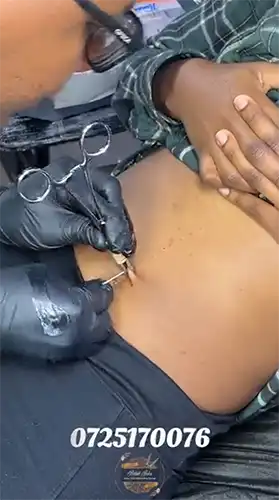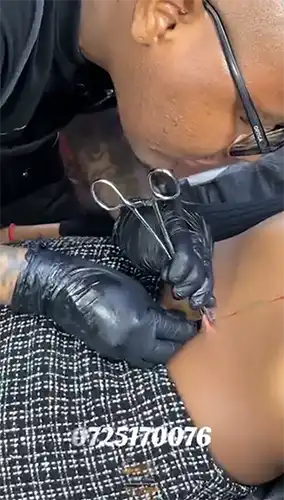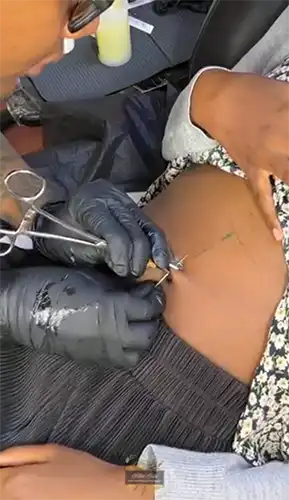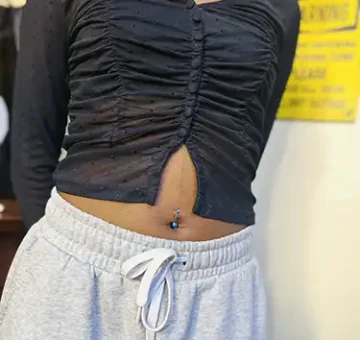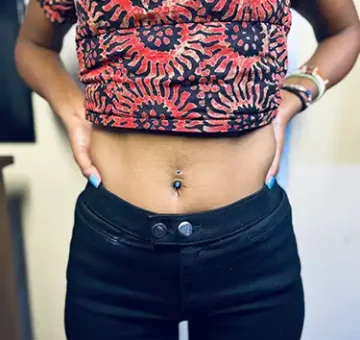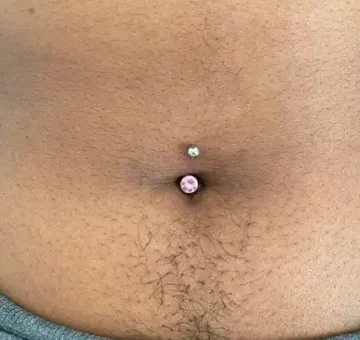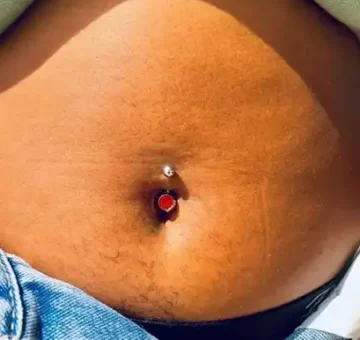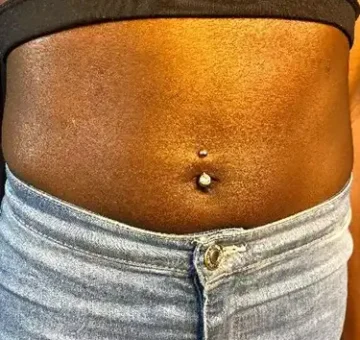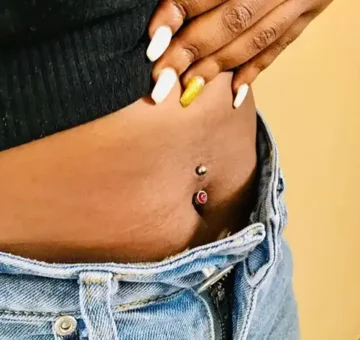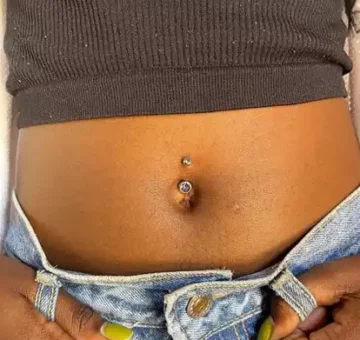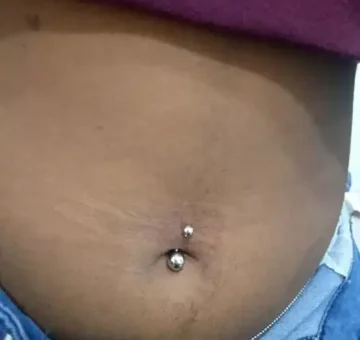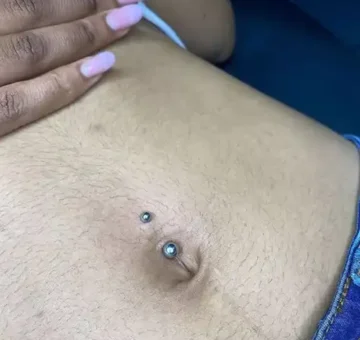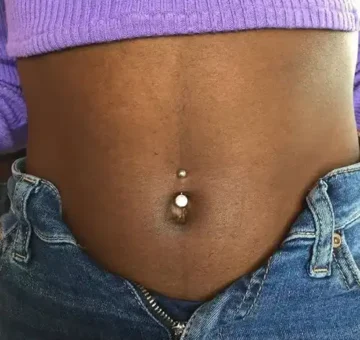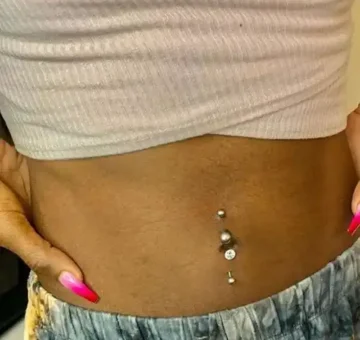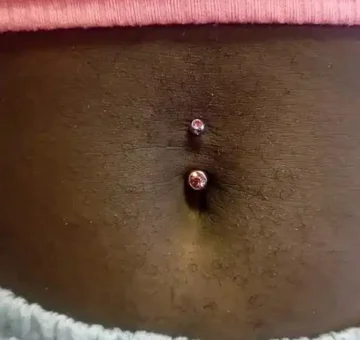Navel (Belly-Button) Piercings in Nairobi, Kenya
A navel piercing is a type of body piercing performed around the belly button (navel). It typically involves inserting jewelry, such as a curved barbell or ring, through the skin and tissue surrounding the navel. This piercing is a popular choice due to its aesthetic appeal, especially for individuals who enjoy showing off their midsection.
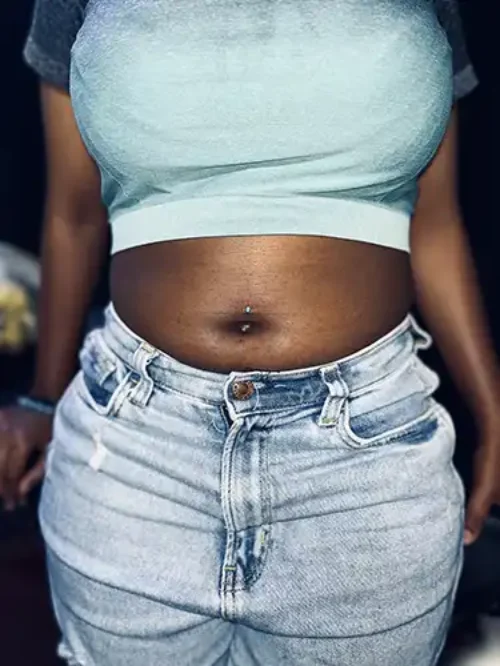
Key Characteristics of Navel Piercings:
- Placement: Most navel piercings are located on the upper rim of the belly button, although variations can include lower, side, or double piercings around the navel.
- Jewelry Types:
– Curved barbells: Most common, featuring a slight curve that fits comfortably.
– Hoops or dangle jewelry: Add flair and style once fully healed. - Healing Process: Healing can take anywhere from 6 months to a year, depending on individual aftercare practices and health.
- Popularity: Often associated with body confidence and fashion trends, it became especially popular in the late 1990s and remains a staple piercing.
Navel Piercing Procedure
The navel piercing procedure typically involves the following steps:
- Preparation: Your piercer will thoroughly wash their hands and put on disposable gloves to maintain cleanliness and prevent the spread of infection. They will also sterilize the piercing equipment and the area around the navel.
- Consultation: Before beginning the piercing, your piercer will have a consultation with you to discuss the procedure, answer any questions or concerns you may have, and ensure you understand the aftercare instructions.
- Marking the piercing: Using a sterile marker, your piercer will mark the entry and exit points for the piercing on your navel. This allows you to review and approve the placement before the piercing begins.
- Piercing: Once you’ve approved the placement, your piercer will use a sterile needle to create the hole for the piercing. The needle is typically hollow, allowing for the insertion of the jewelry.
- Inserting the jewelry: After the hole is created, your piercer will immediately insert the jewelry into the piercing. This is usually done swiftly to minimize discomfort and allow the jewelry to sit properly in the piercing.
- Finishing touches: Once the jewelry is in place, your piercer will clean the area around the piercing again and provide you with aftercare instructions. They may also offer advice on how to minimize discomfort and promote healing.
- Aftercare instructions: It’s essential to follow the aftercare instructions provided by your piercer carefully to ensure proper healing and reduce the risk of infection. This typically includes cleaning the piercing regularly with saline solution or mild soap and water, avoiding tight clothing that may irritate the piercing, and refraining from swimming in pools or bodies of water until the piercing is fully healed.
Throughout the procedure, the piercer should maintain a sterile environment and adhere to strict hygiene practices to minimize the risk of infection. If you have any concerns or questions during the piercing process, don’t hesitate to communicate with your piercer. Your comfort and safety are their top priorities.
Considerations before getting a Navel Piercing
Before getting a navel piercing, it’s important to consider several factors to ensure it’s the right decision for you:
- Health Considerations: Assess your overall health and any medical conditions you may have. If you have a weakened immune system or certain medical conditions, consult with a healthcare professional before getting a piercing to ensure it’s safe for you.
- Pain Tolerance: Understand that getting a piercing involves some level of discomfort or pain. If you have a low pain tolerance, you may want to mentally prepare yourself or consider alternative piercing locations.
- Healing Time: Navel piercings typically take several months to fully heal. Consider whether you’re willing to commit to the aftercare routine and wait for the piercing to heal before engaging in activities that could irritate or disrupt the healing process.
- Lifestyle: Evaluate your lifestyle and daily activities. Certain activities, such as contact sports, swimming, or wearing tight clothing, may need to be avoided during the healing period to prevent complications or discomfort.
- Professional Environment: Some workplaces have policies regarding visible piercings. Consider whether a navel piercing aligns with your workplace’s dress code and if it may impact your professional image or opportunities.
- Allergies and Sensitivities: Be aware of any allergies or sensitivities you have to metals or materials commonly used in piercing jewelry, such as nickel. Opt for high-quality, hypoallergenic materials to minimize the risk of allergic reactions.
- Piercing Studio Selection: Research piercing studios in your area and choose a reputable studio with experienced piercers who prioritize hygiene and safety. Read reviews, ask for recommendations, and visit the studio in person if possible to assess its cleanliness and professionalism.
- Cost: Consider the cost of the piercing, including the initial procedure, jewelry, and aftercare products. While price shouldn’t be the sole determining factor, ensure you’re comfortable with the total cost before proceeding.
- Long-Term Commitment: Navel piercings are semi-permanent and leave a visible scar if removed. Consider whether you’re comfortable with the long-term commitment and potential scarring associated with the piercing.
Carefully considering these factors and consulting with a professional piercer, you can make an informed decision about whether a navel piercing is right for you.
Pain and Healing for a Navel Piercing
Pain Level
The pain of a navel piercing is generally considered mild to moderate. Here’s what to expect:
- Pain Scale: Typically rated 3–5 out of 10, depending on your pain tolerance.
- During the Piercing: You may feel a sharp pinch or pressure as the needle passes through. The discomfort lasts only a few seconds.
- After the Piercing: Mild soreness or tenderness around the navel for a few days.
Factors Affecting Pain:
- Individual pain tolerance.
- Skill of the piercer.
- Thickness of the skin and tissue in the navel area.
Healing Process
- Healing Time:
– Initial Healing: 6–12 weeks.
– Complete Healing: 6 months to 1 year.
Stages of Healing:
- Inflammation (Week 1–2): Swelling, redness, and slight tenderness are normal.
- Scabbing and Crusting (Weeks 3–8): White or clear fluid may form crusts around the jewelry. This is part of the healing process.
- Maturing (Months 3–12): The tissue becomes stronger, and discomfort subsides.
Signs of Proper Healing
- Gradually reduced redness and swelling.
- No pain when moving the jewelry gently (after the initial healing phase).
Schedule Appointment
Naval Piercings FAQ’s
Navel Piercing Aftercare Guide
Proper aftercare is essential to ensure your navel piercing heals well and avoids complications. Here’s a step-by-step guide to caring for your new piercing:
Daily Aftercare Routine
- Clean Twice a Day:
– Use a sterile saline solution or a piercing aftercare spray.
– Dip a clean cotton swab or pad in the solution and gently clean around the jewelry.
– Avoid twisting or turning the jewelry while cleaning. - Avoid Harsh Chemicals: Do not use hydrogen peroxide, alcohol, or antibacterial ointments. These can dry out and irritate the piercing.
- Pat Dry: After cleaning, use a clean paper towel to gently pat the area dry. Avoid using cloth towels, as they can harbor bacteria.
Do’s and Don’ts
Do’s
- Wear loose clothing: Prevent irritation by avoiding tight waistbands or fabrics that can snag on the jewelry.
- Sleep on your back: This reduces pressure on the piercing.
- Stay hydrated and eat healthy: Promotes faster healing.
Don’ts
- Don’t touch unnecessarily: Avoid playing with or adjusting the jewelry.
- Avoid swimming: Steer clear of pools, hot tubs, and oceans for at least 4–6 weeks.
- No excessive movement: Be mindful of activities that stretch or pull the skin around the piercing.
What to Expect During Healing
- Normal:
– Slight redness, tenderness, and a bit of clear or whitish fluid (lymph).
– Light crusting around the jewelry is common. - Abnormal (Contact Us):
– Persistent redness or swelling beyond 2–3 weeks.
– Yellow, green, or foul-smelling discharge.
– Sharp pain or a lump forming around the piercing.
Tips for Long-Term Care
- Wait to Change Jewelry: Only change jewelry after at least 6 months, or when the piercing is fully healed.
- Choose Hypoallergenic Metals: Stick to titanium, surgical steel, or 14k/18k gold to avoid allergic reactions.
- Be Gentle: Even after healing, avoid trauma to the piercing to prevent irritation or migration.
Navel Piercing Jewelry Guide
Choosing the right jewelry is key to enhancing your navel piercing and ensuring proper healing. Here’s what you need to know about navel piercing jewelry:
Types of Navel Jewelry
- Curved Barbells
– The most common and beginner-friendly style.
– Features a slightly curved design that follows the natural shape of the navel.
– Ideal for initial piercings. - Captive Bead Rings (Hoops)
– A circular ring with a removable bead that holds it in place.
– Provides a unique, edgy look.
– Best for healed piercings as they may move more and cause irritation during the healing phase. - Dangle Jewelry
– Curved barbells with decorative, dangling charms.
– Popular for their aesthetic appeal and variety of styles.
– Suitable only after the piercing has fully healed. - Reverse Navel Jewelry
– Designed to hang upward, with decorative elements above the navel.
– A trendy alternative to standard navel jewelry.
Materials for Navel Jewelry
- Titanium
– Hypoallergenic and lightweight.
– Ideal for sensitive skin and initial piercings. - Surgical Steel
– Affordable and durable.
– Not suitable for those with nickel allergies. - Gold
– Use only 14k or 18k solid gold (not gold-plated) to prevent irritation.
– Elegant and timeless but more expensive. - Bioplast or PTFE
– Flexible and hypoallergenic.
– Ideal for active lifestyles or during pregnancy.
Sizes for Navel Jewelry
- Gauge (Thickness): Standard is 14G (1.6mm).
- Barbell Length: Typical length ranges from 10mm to 12mm for most navel piercings.
- Ball Size: The top and bottom balls vary in size, with the bottom usually larger for aesthetic purposes.
Tips for Choosing Jewelry
- Start Simple: For a new piercing, opt for a simple curved barbell in titanium or surgical steel.
- Avoid Heavy or Dangling Pieces: These can cause irritation or migration during healing.
- Be Mindful of Quality: Ensure the jewelry is polished and free of scratches or rough edges.
When to Change Your Jewelry
- Wait until your navel piercing is completely healed (typically 6 months to a year).
- If you’re unsure, consult your piercer to check the healing progress.
- Always clean the new jewelry and your hands before changing.
Cost of Navel Piercings
The cost of a navel piercing can vary depending on several factors, including the location, the reputation of the piercing studio, the expertise of the piercer, the quality of the jewelry used, and any additional services provided.
Here are some factors that can influence the cost:
- Piercer’s Expertise: Experienced and highly skilled piercers may charge more for their services compared to newer or less experienced piercers. At Rebel Inks Tattoos, Tattoo Removal, and Body Piercings Parlour we have experienced professionals who offer quality and premium services.
- Quality of Jewelry: Higher-quality jewelry made from materials like surgical-grade stainless steel, titanium, or gold may come with a higher price tag compared to standard jewelry options.
- Jewelry Material: Hypoallergenic and premium metals like titanium or gold will increase the price.
- Studio Reputation: High-end studios may charge higher prices for premium services.
Estimated Cost
- Studio Fee: Professional navel piercings typically range between Ksh. 1,500- Ksh. 2,500 for the piercing service alone.
- Jewelry Costs:
– Basic jewelry (e.g., surgical steel or titanium): Ksh. 300 – Ksh. 1,000
– Premium jewelry (e.g., 14k/18k gold, decorative pieces): Ksh. 3,000 – Ksh. 10,000 or more.
Navel Price Breakdown Table
Component / Package | Estimated Cost (KSh) | Details / Notes |
Basic navel piercing (procedure only) | 1,500 – 2,000 | Basic process |
Standard package (procedure + basic jewelry) | 2,500 | might includes standard barbell |
Premium titanium jewelry upgrade | 1,000 – 2,000 | Hypoallergenic titanium or designer barbell |
Aftercare kit (saline, instructions) | 500 – 1,500 | Some studios include; others charge extra |
Follow-up / check-up consultation | 500 | Optional post-piercing visit |
Combined Cost:
Total costs are usually between Ksh. 1,500 – Ksh. 10,000, depending on the jewelry selection.
At Rebel Inks Tattoos, Tattoo Removal, and Body Piercings Parlour we take pride in being a reputable piercing studio with experienced piercers who prioritize hygiene and safety. While cost is a consideration, it’s crucial not to compromise on quality when it comes to body piercings. Be sure to inquire about the total cost upfront and ask about the materials used for the piercing and jewelry to ensure you’re making an informed decision.
Possible Side Effects of a Navel Piercing
While navel piercings are generally safe when done by a professional, there are potential side effects to be aware of:
- Initial Discomfort
– What to Expect: Mild pain, redness, and swelling in the first few days.
– Management: Follow proper aftercare and avoid touching the piercing unnecessarily. - Infection
– Signs:
→ Persistent redness and swelling.
→ Yellow or green discharge with a foul odor.
→ Sharp pain or warmth around the area.
– Causes:
→ Poor hygiene during or after the piercing.
→ Exposure to bacteria (e.g., from unwashed hands or tight clothing).
– Prevention: Clean the piercing twice daily with saline solution and avoid swimming in pools or oceans. - Allergic Reaction
– Signs:
→ Itching, rash, or swelling around the jewelry.
– Cause: Sensitivity to certain metals like nickel.
– Solution: Opt for hypoallergenic materials like titanium, surgical steel, or 14k/18k gold. - Migration or Rejection
– What Happens: The body may push the jewelry out, causing it to shift position or leave a scar.
– Causes:
→ Jewelry that is too heavy or poorly fitted.
→ Thin skin or improper placement by the piercer.
– Prevention: Choose high-quality jewelry and ensure a professional performs the piercing. - Keloids or Hypertrophic Scarring
– Signs: Raised, thickened scar tissue forming around the piercing.
– Prevention: Avoid irritating the piercing and follow proper aftercare. If scarring occurs, consult a dermatologist. - Painful Bumps or Abscesses
– What to Watch For:
→ Small lumps or cysts around the piercing.
→ These can sometimes fill with pus and become painful.
– Causes: Irritation, infection, or poor cleaning habits.
– Management: Seek professional advice if the bump persists or worsens. - Delayed Healing
– What Happens: Healing may take longer than the typical 6–12 months.
– Causes:
→ Poor aftercare.
→ Irritation from tight clothing or frequent movement.
– Solution: Be patient and continue proper aftercare. - Embedded Jewelry
– What Happens: Skin may grow over the jewelry if it’s too tight or improperly placed.
– Solution: See a piercer or doctor to safely address the issue.
Get In Touch
For more information on the list above and any other special services,please call or come in for free consultation
Testimonials
After he pierced my industrial piercing and seeing his amazing work, I feel even more excited about getting my tattoo with him in January. I’m really looking forward to it!
I am extremely happy with my new 'Safari' tattoo from Eric at Rebel Inks! The quality of the artwork is fantastic. Eric is a true professional and an amazing artist.
The preparation and design process was thorough and collaborative. He was very patient with my specific requests, including making sure all the elements, which hold personal meaning, were perfect.
The service was friendly and highly professional from start to finish. Despite the 8-hour session, Eric was a pleasant person to spend the time with.
The aftercare guidance and follow-up have been excellent and careful, which has made the healing process easy and better than expected.
I highly recommend Eric for anyone looking for a thoughtful, talented, and caring tattoo artist.
I recommend them 💯
I would definitely recommend if you’re thinking of getting a piercing!
The staff were super friendly, explained everything clearly, and made me feel so at ease. They answered all my nervous questions (and I had many questions),
They walked me through the whole process, gave detailed aftercare instructions, and even followed up afterward to check how I was healing 🫶
Clean, professional, and full of good vibes.
Would 100% recommend . Definitely making a second trip here.
This was the second tattoo I got and I wish I could have come to Eric for my first one! He gave me really great after-care directions for the tattoo as well as a little jar of his own Vaseline-type stuff to put over my tattoo while it was healing! He even put second skin over my tattoo so that I didn’t have to worry about it for the first few days. Now THAT’S good service. My first tattoo artist didn’t do none of that lol.
After the session Eric didn’t rush me and my friend out, he chatted with us and even when he found out I was an artist too— really encouraged me to keep creating and to find a community of artists to support me. I almost cried because I’ve had such a hard time with my own art the past couple of years, it meant so much to me to have a fellow very talented artist say that to me. 🤍🤍🤍
Eric you’re amazing, don’t ever stop creating and just know you’ve impacted lives all over the world!🫶🏻 thanks so much for everything!!
From the moment I walked in, Eric was professional, welcoming, and attentive. He made sure I was comfortable throughout, provided everything I needed, and explained every step of the process. The tattooing itself was unbelievably smooth - I genuinely felt no pain compared to my previous tattoos over the last 22 years.
Eric also gave me excellent aftercare guidance and products, and thanks to that, my tattoo healed beautifully. The attention to detail, precision, and shading are absolutely stunning. This is hands-down the best tattoo I've ever had, and I will be flying back to Nairobi for any future ink.
If you want incredible art, a professional experience, and a talented artist who truly cares about his clients, Rebel Ink is the place to go!
From start to finish, the service was exceptional. The piercer was professional, knowledgeable, and made me feel completely comfortable. The cleanliness of the place was above and beyond — everything was spotless and hygienic, which really put me at ease. Highly recommend for anyone considering a piercing!
Shout out to Eric😘
We ended up changing the jewelry three times to ensure I had the best fit and avoided any signs of rejection, and he always listened to my suggestions as a client, which I really appreciated. Now, three months in, my piercing is healing beautifully, with no sign of rejection. Highly recommend for anyone who values a piercer who cares about your comfort and healing journey!
What stood out the most was the aftercare Eric checked in with me even three weeks later to see how the tattoo was healing. That kind of follow-up shows how much he truly cares about his work and his clients.
I’m very satisfied and will definitely be coming back for my next piece. Highly recommend!
The piercing wasn't as painful as I had thought and the process was quick and satisfactory. I love it!!!
The piercing is healing well thanks to the aftercare instructions and follow-up. I would highly recommend Rebel Inks
Eric also did a belly button piercing for a friend, guiding her through the process, doing the piercing and then explaining the after care to her.
The shop is on the 3rd floor, with the entrance to the stairs near an alleyway on the left. The shop is perfect size, clean, and attractive looking. The mural is pretty dope.
Thank you for the amazing service! 🔥👅✨
I got piercibgs there and the process was really good. My biggest concern was hygiene but that wasn't an issue at all, they use new needles and they sanitize them.
The service itself was also welcoming.
I was informes of everything i needed to know beforehand.
10/10 would recommend!
Eric was so calm and patient with my almost 2 year old lady. It was such a clean and hygienic process. We will definitely be back for our second rounds of piercings and maybe even another tattoo!
They assess the area before any art and advise one accordingly. They also give one post clean up process and also do a check up after the body art projects. Overall, I loved my experience and I’m hooked. 👍
Will definitely come back next time I’m in town 🙂
He listened to what I actually wanted and made sure he could fit in the time before I flew back home.
The shop is clean & private and is easy enough to find.
Eric has even checked in a couple of times since to make sure all is good.
I would totally recommend Eric! I absolutely love my Elephants!
I had a very easy healing period and always follow up from Eric to check on my progress...I would highly recommend if you are a first timer because from my experience all went very well and attention to detail
Thank you for a good job and looking forward to send all my friends your way
And all the best with the new year 2025!
From the moment I walked in, the staff was super friendly and made me feel at ease. The studio had a clean, professional atmosphere, which immediately put me at ease. My piercer was incredibly skilled and explained every step of the process, ensuring I was comfortable the entire time. The piercing was quick and practically painless, and the aftercare instructions were clear and easy to follow. I can tell they really care about the health and safety of their clients.
Overall, a fantastic experience—I highly recommend Rebel Inks and Tattoos for anyone looking to get pierced or tattooed!
They do follow up after their services
Eric's Studio isn’t just a place to get a tattoo—it’s an experience. The combination of professionalism, artistic talent, and a welcoming environment makes it a standout destination for anyone considering a tattoo.
I highly recommend Eric’s Studio to both first-timers and seasoned tattoo enthusiasts. If you’re looking for a high-quality tattoo and an enjoyable experience, this is the place to go.
I would definitely recommend their services again and again
Thank you Rebel Ink
My piercings are healing ❤️🩹 well
I would 💯 recommend
I will definitely come back for more .
Two, all the equipments he used for the piercings were new and/or sterilised.
Three, the parlour itself was very clean and was up to par with the hygiene standards.
Four, Eric provided effective aftercare instructions, making sure I knew exactly how to take care of my new piercings and he kept in touch and continues to do so, to check on the healing progress.
I highly highly highly recommend this place!!!
Would definitely recommend them to friends and go back for other piercings
Not only was the piercing process smooth, but he also provided thorough aftercare instructions, making sure I knew exactly how to take care of my new piercings. What really impressed me was that he keeps in touch to check on how the healing is progressing – a sign of true care for his clients.
The shop maintains a high standard of hygiene, and the atmosphere is welcoming and comfortable, which really added to the positive experience. I highly recommend this place to anyone looking for a professional and caring experience. I’ll definitely be coming back for any future piercings!
My appreciation for the excellent customer service I received. The follow-ups were prompt, and I truly appreciated the gentleness and professionalism throughout. Thank you!"
"Looking for professional eyebrow microshading removal? Look no further!"
The customer care is top tier 👌🏾👌🏾.
Wonderful place to get tattoos and piercings. 💯💯
Eric goes ahead to follow up on his clients progress and gives good advice each time I reach out to him.
I would recommend Reble tattoos anytime.
Good job bro we really appreciate.
Ohh and the price is very fair.
The environment was clean , procedure was sterile and the jewelry used are of the best quality.
He followed up with me during the healing process, he educated me on what I needed to do for my aftercare.
Eric is confident, skilled , experienced and the best piercer. Highly recommend Rebel inks.✨
Definitely recommend!
Great experience.
Eric definitely know what he is doing .
I got exactly what I wanted 2 tiny tats on the same finger .
He was kind and patient throughout the session.
Healing process has been good .
Aftercare services were given and regular checkups on the healing process were done.
I would 💯recommend.
Eric gave me the best reception as it was my first time there,and made me trust him all the way. I appreciate good services.
There services are also affordable not to forget 😊.
He was also invested in the aftercare and would ensure I follow the do's and don'ts in taking care of the tattoo and ensuring proper healing and maximum ink retention.
Would highly recommend Rebel Inks Tattoos.
Rebel Inks Tattoo offer the best,affordable and quality tattoo removal services.If you have unwanted ink,choose Rebel Inks Tattoo,they're the best of the best and the professionalism is a top notch.They ensure you're free from unwanted ink with their Laser Tattoo Removal Technology...
I did a Laser Tattoo Removal with them and i can attest they're the best....
Kudos Eric...
I highly recommend.
It was a generally good experience with good hygiene during the piercing process and has been a smooth healing process.... 10/10
tips. Highly recommend 👍🏽
100% recommendable.
I was particularly impressed with Eric's attention to hygiene. He thoroughly cleaned the room before I entered, sanitized all of the equipment he would be using, and changed gloves between each ear. This level of cleanliness gave me great confidence in his professionalism.
Eric's commitment to customer service did not end on the day of the piercing. He followed up with me regularly throughout the healing process to ensure that I was following the aftercare instructions and that my earlobes were healing properly.
I highly recommend Rebel Inks to anyone in Nairobi who is considering getting a piercing. Eric is a highly skilled and experienced piercer who takes great pride in his work.
So I Check all the boxes below and more:
Customer Care: ✔️
Professionalism : ✔️
Cleanliness ✔️
Price: ✔️
After care service ✔️
Thanks and good job, Eric
The place is neat and clean and the equipments he used were also fine standards. Really appreciate his following up with me on the healing 🤗
I WOULD HIGHLY RECOMMEND THEIR SERVICES to everyone. Actually what you see on their website is EXACTLY what you will get. Keep up the good work Rebel inks Tattoos.
The infection is now gone. I would definitely recommend!
Can recommend this place totally and would go back there anytime!
Thanks!
OUR LOCATION
Areas We Serve
NAIROBI
KIAMBU
KAJIADO
MACHAKOS

